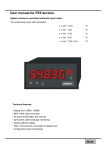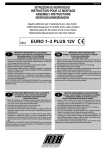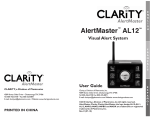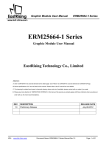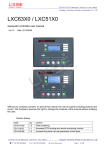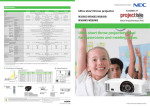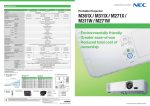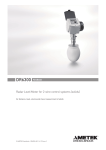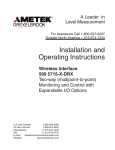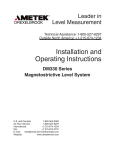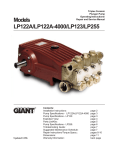Download Manual - 405-5100 Series, Continuous Ultrasonic
Transcript
DREXELBROOK Leader in Level Measurement For Assistance Call 1-800-527-6297 Outside North America Call + 215-674-1234 Installation and Operating Instructions Series 505-5100 Continuous Ultrasonic Transmitter using 405-5100 Electronics Software Version VAL4.85 + 215-674-1234 Outside North America 1-800-553-9092 US and Canada www.drexelbrook.com [email protected] Need More Instruction Books ? Go to www.drexelbrook.com Look under this specific product Download Instruction Manual AMETEK Drexelbrook makes no warranty of any kind with regard to the material contained in this manual, including, but not limited to, implied warranties or fitness for a particular purpose. Drexelbrook shall not be liable for errors contained herein or for incidental or consequential damages in connection with the performance or use of material. Copyright 2002 AMETEK Drexelbrook EDO#12-02-243 505-5100-LM Series 505-5100 Continuous Ultrasonic Transmitter using 405-5100 Electronics Software Version VAL4.85 DREXELBROOK An ISO 9001 Certified Company 205 Keith Valley Road Horsham, PA 19044 US Sales 1-800-553-9092 24 Hour Service 1-800-527-6297 International + 215-674-1234 Fax + 215-674-2731 E-mail [email protected] Web www.drexelbrook.com EDO#12-02-243 505-5100-LM Table of Contents Section 1 - Introduction ................................................................................................ 1 1.1 Product Description ................................................................................................ 1 1.2 Technology ............................................................................................................. 1 1.3 Models Available .................................................................................................... 1 1.4 Key Terms ............................................................................................................... 3 1.5 Types of Output ....................................................................................................... 3 Section 2 - Installation .................................................................................................. 4 2.1 Unpacking ............................................................................................................... 4 2.2 Mounting the Transmitter ........................................................................................ 4 2.3 Wiring the Transmitter ............................................................................................. 8 Section 3 - Operation .................................................................................................. 10 3.1 Indicators and Controls ......................................................................................... 10 3.2 Time Delay and Repetition Rate ........................................................................... 13 3.3 Step Gain Switch .................................................................................................. 14 3.4 High Discrimination Units ..................................................................................... 14 Section 4 - Calibration ................................................................................................ 15 4.1 Introduction ........................................................................................................... 15 4.2 Calibration ............................................................................................................ 15 4.3 Setpoint Calibration .............................................................................................. 18 4.4 Relay Package (Optional) ..................................................................................... 19 Section 5 - Troubleshooting ....................................................................................... 22 5.1 Troubleshooting Procedures ................................................................................. 22 5.2 Factory Assistance................................................................................................ 24 5.3 Field Service ........................................................................................................ 24 5.4 Customer Training ................................................................................................ 24 5.5 Equipment Return ................................................................................................. 25 Section 6 - Specifications ........................................................................................... 26 6.1 Transmitter Specifications..................................................................................... 26 6.2 Transducer Specifications .................................................................................... 27 505-5100 Series Ultrasonic TransmitterTM SECTION 1 INTRODUCTION 1.1 Product Description The Drexelbrook Series 505-5100 Liquid Level Transmitter is an integral assembly which accurately measures continuous level up to a range of 80 feet, using ultrasonic technology. The level measurement output is a 4-20 mA Vdcsignal. The ultrasonic transducer does not contain moving components. It is not affected by electrical or physical parameters and has a wide range of temperature operation. The sensing element is made of CPVC for compatibility with a wide range of process materials. 1.2 Technology Ultrasonic transmitters work on the principle of sending a pulsed, high-frequency sound wave from a peizo electric transducer to the contents of the vessel. The device measures the length of time it takes for the reflected sound wave to return to the transducer. A successful measurement depends on reflection from the process material in a straight line back to the transducer. The two basic modes of operation are the “delta level” and “delta distance.” In the delta level mode, the current output (4-20 mA dc) increases as the liquid level rises. In the delta distance mode, the current output increases as the level falls (distance to the transducer increases). The desired span range may be set from a minimum of 3 inches up to 80 feet. To ignore obstructions in the vessel, AutoprofilingTM tank mapping has been developed, which allows a “sonic snapshot” of an empty vessel. The transducer transmits a sound burst and the echo is recorded as a signature of the tank. Any obstructions in the vessel will send an echo and create a profile. Later on, this signature or profile is locked into the ultrasonic unit’s memory so it will not respond to echoes created by these obstructions. 1.3 Models Available 505-51X0-X02- Continuous Ultrasonic Transmitter with 4-20 mA Configuration options: 0 - Integral Electronics 7 - Remote Electronics Electronic Unit options: 1 - High Discrimination Electronic Unit 2 - Adjustable Gain Electronic Unit Diagram on following page identifies components. 1 505-5100 Series Ultrasonic TransmitterTM —Legend 1 Operating Mode Switch (Time Delay/Rep Rate Control) see section 3.1 2 Calibration Switches see sections 3.1 and 4.2 3 Optional Setpoint Switches see section 4.3 7 Transducer Terminal Strip see section 2.3 8 24 Vdc Alarm Outputs see sections 3.1 9 Signal Loop Terminals see section 2.3 4 Switch 8 see sections 3.1 and 4.2 10 Sink/Source Mode Selector Jumper Block see section 2.3 5 Near Zone and Lost Echo LEDs see sections 2.2 and 3.1 11 Power Terminals see section 2.3 6 Calibration Pushbutton and System Reset see section 3.1 12 Step Gain Switch (not available with High Discrimination units) see section 3.3 13 Connector to 15 Vdc for optional Relay Package see section 4.4 2 505-5100 Series Ultrasonic TransmitterTM 1.4 Key Terms Zero: The point at which the output is to equal 4 mA (0% level) measured from the transducer face down (â). Span: The point at which 20 mA (100%) occurs measured from the zero point. Range: Maximum distance from the transducer face. 1.5 Types of Output Near Zone: The distance just below the transducer face where the transmitter cannot make a level measurement (30 inches). Lost Echo: A condition that occurs when the acoustic energy is not being returned to the transducer. Loss of echo may occur when large amounts of foam are present. Level Mode: Output increases as level increases. Level mode output is the most common type of output measurement. Distance Mode: Output decreases as level increases. Source Mode: Transmitter provides 24 Vdc to drive the loop (standard). Sink Mode: Jumper has been moved to allow the transmitter to receive 24 Vdc from an external supply. 3 505-5100 Series Ultrasonic TransmitterTM SECTION 2 INSTALLATION 2.1 Unpacking Carefully remove the contents of the shipping carton and check each item against the packing list before destroying any packing material. If there is any shortage or damage, report it to the factory immediately. 2.2 Mounting Transmitter The 505-5100 Series ultrasonic transmitter is available with the electronic unit and transducer as either a single integral assembly or connected by 2 coaxial cables in the remote configuration. Extended sensing element lengths and special mountings can be provided to fit specific mounting applications. Refer to Figures 2-2 and 2-3 for standard mounting dimensions. • The 505-5100 Series transmitter is designed for field mounting, but it should be mounted in a location as free as possible from vibration, corrosive atmospheres, and any possibility of mechanical damage. • For convenience when adjusting, place the electronic unit in a reasonably accessible location. Ambient temperature should be between -40oF and 160oF (-40oC to 70oC). • The transducer axis must be mounted perpendicular to the liquid surface. • Ensure that the transducer face is not recessed into a mounting nozzle, as stray reflections can cause faulty operation. NOTE NOTICE If the transducer must be mounted in a nozzle, use a 505-5110 High Discrimination unit. • When mounting the transducer, consideration must be given to the 30-inch Near Zone. If the level rises to within 30 inches of the sensing element face, a 4 or 20 mA signal (20=level mode, 4=distance mode) will be generated; the Near Zone LED will light; and the Near Zone Alarm Output will drop from 24 Vdc to 0 Vdc. • When mounting the transducer, consideration must be given to the beam angle of the acoustic signal. The typical conical beam angle of the acoustic signal is 12 degrees (6 degrees from center). Mount the transducer so that the beam does not hit the tank wall, ladder rungs, or other obstructions. 4 505-5100 Series Ultrasonic TransmitterTM 2.2 Mounting Transmitter (continued) Application Example Since the maximum distance that the 505-5100 ultrasonic transmitter can sense is 80 feet and the acoustic beam spreads out at a rate of 1.25 inches per foot, the transducer should be mounted 100 inches from the tank wall. If it isn’t possible to mount the transducer the required distance from the tank wall and the acoustic beam does strike the side wall of the tank, then some acoustic energy will be lost. If the sidewall is relatively smooth, some signal loss can be tolerated; but any structure or 90 degree obstructions on the sidewall may be detected. See Figure 2-1. CAUTION If the Series 505-5100 is located in a hazardous environment, do not open enclosure cover or make/break any electrical connections without first disconnecting electrical power at the source. Ensure that wiring, electrical fittings and conduit connections conform to electrical codes for specific location and hazard level. CORRECT INCORRECT CORRECT DREXELBROOK DREXELBROOK DREXELBROOK 5 5 5 INCORRECT DREXELBROOK 5 FILL LINE DREXELBROOK DREXELBROOK 5 5 DREXELBROOK TANK STRUCTURE ECHO STRONGER THAN LEVEL 5 TOO MUCH LOST ENERGY LOST ENERGY 6o STRONG WEAK TOO CLOSE TO WALL OK BEAM ANGLE Figure 2-1 Mounting Recommendations 5 6o 505-5100 Series Ultrasonic TransmitterTM Figure 2-2 505-5100 Series Mounting Dimensions Integral Mounting 6 505-5100 Series Ultrasonic TransmitterTM Figure 2-3 505-5100 Series Mounting Dimensions Remote Mounting 7 505-5100 Series Ultrasonic TransmitterTM 2.3 Wiring Transmitter Refer to Figures 2-4 through 2-6 for the wiring diagrams of the 505-5100 transmitters. Connect input power and output leads to terminal block (TB1) as shown. The 5055100 is shipped with the Output Select jumper block set to source (the unit will supply all power to the signal loop.) If an external power supply is used, jumper should be moved to sink position. Section 3 - Operation describes the other indicators and controls. For integral transmitters, the level measuring cable and temperature compensation wires are prewired. Figure 2-6 shows the customer wiring of the level and temperature cables for remote-mounted units. Figure 2-4 Output Select Jumper Block and Input Power Terminal Block (TB1) 120/240 Vac Unit 8 505-5100 Series Ultrasonic TransmitterTM Figure 2-5 Output Select Jumper Block and Input Power Terminal Block (TB1) 24 Vdc Unit Figure 2-6 Sensing Element Wiring Connections, Remote Transmitter 9 505-5100 Series Ultrasonic TransmitterTM SECTION 3 OPERATION Refer to Figure 3-1 for the location of indicators and controls. 3.1 Indicators & Controls —SW8 Level/Distance Mode Selection Lost Echo Fault Output Selection The selection of either level or distance mode is accomplished by changing switch position 4 on SW8. Level and distance modes are explained in Section 1.4. • When SW8-4 is switched down (OPEN), the transmitter operates in level mode. • When SW8-4 is switched up (ON), the transmitter operates in distance mode. Switch position 2 of SW8 is used to set the lost echo fault output. • When SW8-2 is in switched down (OPEN), the transmitter will produce 4 mA output during a lost echo condition. • When SW8-2 is switched up (ON), the transmitter will produce 20 mA output during a lost echo condition. Application requires Overfill Prevention (no spills) Application requires Low Level Prevention (pump will not run dry) Material cannot go over high point Material cannot go below low point Lost Echo typically set 20 mA Lost Echo typically set 4 mA —Time Delay/Rep Rate Control The time delay/repetition rate control is located above SW8. The time delay can be set to 0,15, or 45 seconds and the repetition rate (time between ultrasonic pulse transmissions) can be set to 140, 280, or 420 milliseconds. • A 0-second time delay and 140 millisecond repetition rate (position 0) is the factory-set default. • A 280 millisecond repetition rate is used for domed-top tanks. • Consult factory to use a 420 millisecond repetition rate. Refer to Section 3.2 for more details. 10 505-5100 Series Ultrasonic TransmitterTM 3.1 Indicators & Controls —Zero and Span Calibration Switches (continued) The zero and span are each set using three, ten-position rotary switches. Zero and span settings are made in inches with 1-inch resolution. Zero and span switches are used to calibrate the unit, discussed in Section 4.2. —LED Indicators Two LED indicators are located on the transmitter to alert the user to a near zone or lost echo condition or improper calibration. —Calibration Pushbutton The calibration pushbutton is used in conjunction with SW8 for maximum calibration accuracy. This button can also be used as a system reset. —Alarm Relays Outputs (24 volts @ 35 mA) for near zone, lost echo and 2 alarm setpoints are provided to activate external relays or alarms. These are separate relay packages purchased as an option. —Step Gain Switch Changes the gain of the ultrasonic transmitter to lessen any effect due to noise or obstruction. (Not available on High Discrimination chassis.) 11 505-5100 Series Ultrasonic TransmitterTM Figure 3-1 Indicators and Controls 12 505-5100 Series Ultrasonic TransmitterTM 3.2 Time Delay and Repetition Rate Certain applications may require a change of repetition rate and time delay. • Increasing time delay to either 15 or 45 seconds will smooth out a jumpy output signal caused by wave action or turbulence in the tank. • Changing the repetition rate is required any time that the tank roof is curved. A longer repetition rate ensures that the transmitter is not affected by reflected sound waves from the curved roof. • A lengthened repetition rate also helps reduce loss of echo due to foam. If your application is similar to one described above, change the time delay or repetition rate using a small screwdriver and switch SW4. Table 3-1 details the switch settings. Each setting controls both time delay and repetition rate. Table 3-1 Time Delay and Repetition Rate Switch (SW4) Settings Switch Position Time Delay 0 1 2 3 4 5 6-9 A-F 0 seconds 15 seconds 45 seconds 0 seconds 15 seconds 45 seconds not used not used Repetition Rate 280 msec 280 msec 280 msec 420 msec 420 msec 420 msec not used not used A step gain switch is available on standard 505-5100 units. The step gain switch can be used to decrease the acoustic signal and avoid noise interference. For example, the standard chassis is capable of shooting to a distance of 80 feet. The extra power produced to shoot the 80foot signal might be too much and could possibly cause nuisance reflections from irregular sidewalls, tank obstructions, or agitator blades. By reducing the gain of the chassis using the step gain switch, the effect of nuisance reflections can be eliminated. 13 505-5100 Series Ultrasonic TransmitterTM 3.3 Step Gain Switch The factory setting is position 6. This setting should be adequate for most applications. If false high readings occur, decrease the gain. Step Gain Switch 6 5 4 3 2 1 3.4 High Discrimination Units 100% gain 80 % gain 67% gain 50% gain 40% gain 30% gain 20% gain High discrimination chassis (405-5110) contains an additional circuit that automatically reduces the effect of nuisance echos created when mounting the transducer in a nozzle. This circuit allows mounting the transducer inside a pipe up to 14 inches above the tank opening. Also, the high discrimination circuit lessens any effect from agitator blades and/or small obstructions and reduces interference caused by electrical noise. The high discrimination electronics unit should not be used in applications where foam is present. 14 505-5100 Series Ultrasonic TransmitterTM SECTION 4 CALIBRATION 4.1 Introduction The 505-5100 Series transmitters are set at the factory to operate, in most applications, with minimal calibration. However, it is still necessary to set the Zero and Span switches for your actual vessel. This procedure is outlined in Section 4.2. Once this procedure is accomplished the level reading should be within approximately 1% accuracy of range. Use this procedure to set the Zero and Span for the vessel. Choose Level or Distance mode: 4.2 Calibration —Level Mode With the power off, verify that all four switches on SW8 are DOWN (open). Refer to Figure 4-1. Set the Zero calibration switches to equal the distance in inches from the transducer face down to the minimum level (usually tank bottom–0% or 4 mA). Refer to the calibration example in Figure 4-2. For this example, the switches are set to 1-8-6 starting with the top switch. Set the Span calibration switches to equal the distance in inches from the minimum level to the maximum level— 100% point or 20 mA (e.g. 1-5-6 starting with top switch). Span setting must be at least 30 inches less than zero setting —Distance Mode With the power off, verify SW8 is configured properly. Switches 1-3 are DOWN (open) and switch 4 is UP (on). See Figure 3-1. Set the Zero calibration switches to equal the distance in inches from the sensing element face to the maximum level (0% or 4 mA). Refer to the calibration example in Figure 4-2. For this example, the switches are set to 0-3-0 starting with the top switch. Zero switches must not be set lower than 0-3-0. Set the Span calibration switches to equal the distance in inches from the maximum level to the minimum level— 100% or 20 mA (e.g. 1-5-6 starting with the top switch). NOTICE NOTE The maximum level point must be at least 30 inches from the sensing element (near zone). Apply power; the 4-20 mA should now represent the amount of material in the vessel to within approximately 1%. 15 505-5100 Series Ultrasonic TransmitterTM 4.2 Calibration (continued) Figure 4-1 Calibration and Alarm Switches NOTICE NOTE If, after calibration, the unit is not reading within 3% of actual level, call Factory Service at 1-800-527-6297. 16 505-5100 Series Ultrasonic TransmitterTM Level Mode Distance Mode Figure 4-2 Calibration Example 17 505-5100 Series Ultrasonic TransmitterTM 4.3 Setpoint Calibration (only for those units equipped with optional 24 Vdc outputs) a. Refer to Figure 4-1 for location of alarm switches (ALM1 and ALM2). b. Alarm points are set directly in inches from the zero point. Normally, 24 Vdc is present on the male pins J4-J7, measured from the pins to common. When a setpoint alarm is exceeded, the voltage drops to 0 Vdc. In the calibration example of Figure 4-2, the low alarm point would be set 6 inches from the zero point or minimum level. Starting with the top switch of ALM1, the settings would be 0-0-6. The high alarm point is 6 inches from the maximum level, which is 156 inches in this example. Starting with the top switch of ALM2, the settings would be 1-5-0 (span — 6 inches). c. Alarm settings ALM1 and ALM2 can be set to alarm at any point in the calibrated range. d. Connections are made to the transmitter using female connectors to J4, J5, J6, J7 and common connection, as shown in Figure 4-3. Figure 4-3 Alarm Relay Connections (J6 and J7) 18 505-5100 Series Ultrasonic TransmitterTM 4.4 Relay Package (Optional) As an option, a 401-600 external relay package is available. This package can provide remote-mounted relay outputs for Alarm 1, Alarm 2, Lost Echo and Near Zone. This package can also be equipped with remote LEDs to indicate Loss of Echo or Near Zone. A short cable (Figure 4-4) is available to connect the 401-600 to the ultrasonic chassis. Cable 380-5000-053 contains 36 inches of ribbon cable with 5 colored crimp connectors (labelled 2 through 6 on Figure 4-4) and 1 non-crimped connector (labelled 1 on Figure 4-4). The non-crimped connector is only required if using a relay package that contains remote LEDs for indicating Lost Echo or Near Zone. Figure 4-4 Cable to Optional Relay Package 19 505-5100 Series Ultrasonic TransmitterTM Figure 4-5 Optional Relay Package, Wiring 20 505-5100 Series Ultrasonic TransmitterTM Figure 4-6 Optional Relay Package System Configuration and Mounting Dimensions 21 505-5100 Series Ultrasonic TransmitterTM SECTION 5 TROUBLESHOOTING The 505-5100 Transmitter is designed to give years of unattended service. No periodic or scheduled maintenance is required. 5.1 Troubleshooting Procedures If a problem should occur with the operation of the transmitter, use the following procedure for troubleshooting. a. Ensure wiring connections are correct. b. If the liquid surface has severe turbulence in the area where the ultrasonic beam hits, consider setting SW4 to add 15 or 45 seconds damping to 4-20mA loop. c. Any continuous ultrasonic transmitter signal/echo can be adversely affected by significant foam on the liquid level surface. If this condition exists, please consult the factory for further application review and advice. d. Ensure that the transducer face is not recessed into a mounting nozzle, unless High Discrimination electronics are used. Spurious reflections from the nozzle openings into the vessel can cause faulty operation. e. If attempts to locate the difficulty fail, notify the local factory representative, or call the factory toll-free at 1-800-527-6297. To aid in troubleshooting, please complete the information on Table 5-1 before calling the factory service department. 22 505-5100 Series Ultrasonic TransmitterTM Table 5-1 ULTRASONIC PHONE TROUBLESHOOTING Transmitter Model Number __________________Serial Number____________________ Process Material_________________Temperature_______________Pressure_____________ What is the Loop Current? ____________ Is it stable?________________ Test the ability of the electronic unit to produce 4 and 20 mA. Place switch 3 of SW8 to the ON position (up). Now by alternating switch 2, ON (up) position should =4 mA. OFF (down) position should =20 mA. Are either of the 2 red LEDs illuminated? ________ (if yes, which one?)_______________ Check for correct voltage on TB1 (see Figure 2-4). ___________ Loop supply voltage is measured at TB2 (with no load) should be 24-30 Vdc in source mode. What is the position of the hex switch SW4 (factory setting is zero)? (See Figure 3-1.) What is the position of the step gain switch (factory setting is 6)? (See Figure 2-5.) What are the switch positions of SW8? (See Figure 3-1). (All should be DOWN (off) with the exception of position 4—it can be either UP (on) or DOWN (off). SW8 List the positions of the Span and Zero rotary calibration switches (Figure 3-1.) SW1, SW2, SW3, SW5, SW6, AND SW7? SW1____ SW5____ In level mode Zero must always be larger than Span. SW2____ SW6____ SW3____ SW7____ Transducer Temperature Check: • Expect to find 0.65 Vdc between brown terminal [BRN] and housing. • Should be able to measure approximatly 290 µA on digital meter placed in series with orange lead and its terminal [ORG]. With sensing element disconnected, expect reading of 12K ohm between center wire terminal [CW] and shield [SHD], using an analog meter.. 23 505-5100 Series Ultrasonic TransmitterTM 5.2 Factory Assistance AMETEK Drexelbrook can answer any questions about your level measurement system. Call Customer Service at 1-800-553-9092 (US and Canada) , or + 215-674-1234 (International). If you require assistance and attempts to locate the problem have failed: • Contact your local Drexelbrook representative, • Call the Service department toll-free at 1-800-527-6297 (US and Canada) or + 215-674-1234 (International), • FAX the Service department at + 215-443-5117, or • E-Mail to [email protected] Please provide the following information: Instrument Model Number ___________________________ Sensing Element Model Number and Length ___________ Original Purchase Order Number _____________________ Material being measured _____________________________ Temperature __________________________________ Pressure ______________________________________ Agitation ______________________________________ Brief description of the problem _______________________ ____________________________________________________ ____________________________________________________ Checkout procedures that have failed __________________ ____________________________________________________ ____________________________________________________ 5.3 Field Service Trained field servicemen are available on a time-plus-expense basis to assist in start-ups, diagnosing difficult application problems, or in-plant training of personnel. Contact the service department for further details. 5.4 Customer Training Periodically, AMETEK Drexelbrook instrument training seminars for customers are held at the factory. These sessions are guided by Drexelbrook engineers and specialists, and provide detailed information on all aspects of level measurement, including theory and practice of instrument operation. For more information about these valuable workshops, write to AMETEK Drexelbrook, attention: Communications/ Training Group, or call direct + 215-674-1234. 24 505-5100 Series Ultrasonic TransmitterTM 5.5 Equipment Return In order to provide the best service, any equipment being returned for repair or credit must be pre-approved by the factory. In many applications, sensing elements are exposed to hazardous materials. • OSHA mandates that our employees be informed and protected from hazardous chemicals. • Material Safety Data Sheets (MSDS) listing the hazardous materials to which the sensing element has been exposed MUST accompany any repair. • It is your responsibility to fully disclose all chemicals and decontaminate the sensing element. To obtain a return authorization (RA#), contact the Service department at 1-800-527-6297 (US and Canada) or + 215-674-1234 (International). Please provide the following information: Model Number of Return Equipment ____________________ Serial Number _________________________________________ Original Purchase Order Number _______________________ Process Materials that equipment has been exposed to _____________________________________________________ MSDS sheets for any hazardous materials Billing Address ________________________________________ ______________________________________________________ Shipping Address ______________________________________ ______________________________________________________ Purchase Order Number for Repairs _____________________ Please include a purchase order even if the repair is under warranty. If repair is covered under warranty, you will not be charged. Ship equipment freight prepaid to: AMETEK-DREXELBROOK. 205 KEITH VALLEY ROAD HORSHAM, PA 19044-1499 COD shipments will not be accepted. 25 505-5100 Series Ultrasonic TransmitterTM SECTION 6 SPECIFICATIONS 6.1 Transmitter Specifications Near/Dead Zone: 30 inches (62 cm) Minimum Span: 6 inches (15.2 cm) or 10% of calibrated range (whichever is greater) Maximum Span: 80 feet (24.4 m) 2-Wire Signal Loop: 4-20 mA DC (isolated) source or sink •Load Voltage: Source Mode, 24 Vdc output Sink Mode, 8-60 Vdc input •Loop Resistance: Source Mode, 0-1000 ohms (@ 24 Vdc) Repeatability: 0.10 inch (3mm) Resolution: 0.30 inch (8mm) Linearity: 0.2% of full scale for spans less than 3 feet. Ambient Temperature: -40o to 160oF (-40o to 70oC) Temperature Compensation: Automatic Calibration: To nearest 1 inch (2.5 cm) Zero and Span range switches, ranges are set directly in inches. Power Requirement: 120 Vac, 50/60 Hz; 240 Vac, 50/60 Hz; or 24 Vdc at 250 mA (without relays) Power Consumption: 6 watts @ 120 Vac Response Time: 2 seconds (approx.) 26 505-5100 Series Ultrasonic TransmitterTM 6.1 Transmitter Specifications Damping: 0,15, or 45 second response time (field-selectable) Lost Echo: LED indication, loop current 4 mA Additional output: 24 Vdc 35 mA max. Near Zone: LED indication, loop current 20 mA Additional output: 24 Vdc 35 mA max. Optional Alarm Outputs: 2 outputs: 24 Vdc 35 mA maximum Alarm points are set in inches. Pulse Repeat Rate: 280 or 420 mS (field-selectable) Mounting: Integral or Remote 4" NPT fitting (flange mounts available) (continued) 6.2 Transducer Specifications Sensing Element Material: CPVC Beam Angle: Conical, 12o typical, 3dB down outside the cone Process Temperature: -40oF to 160oF(CPVC) (-40oC to 70oC) Process Pressure: -10 to 50 PSIG 27 DREXELBROOK An ISO 9001 Certified Company 205 Keith Valley Road Horsham, PA 19044 US Sales 1-800-553-9092 24 Hour Service 1-800-527-6297 International + 215-674-1234 Fax + 215-674-2731 E-mail [email protected] Web www.drexelbrook.com




































